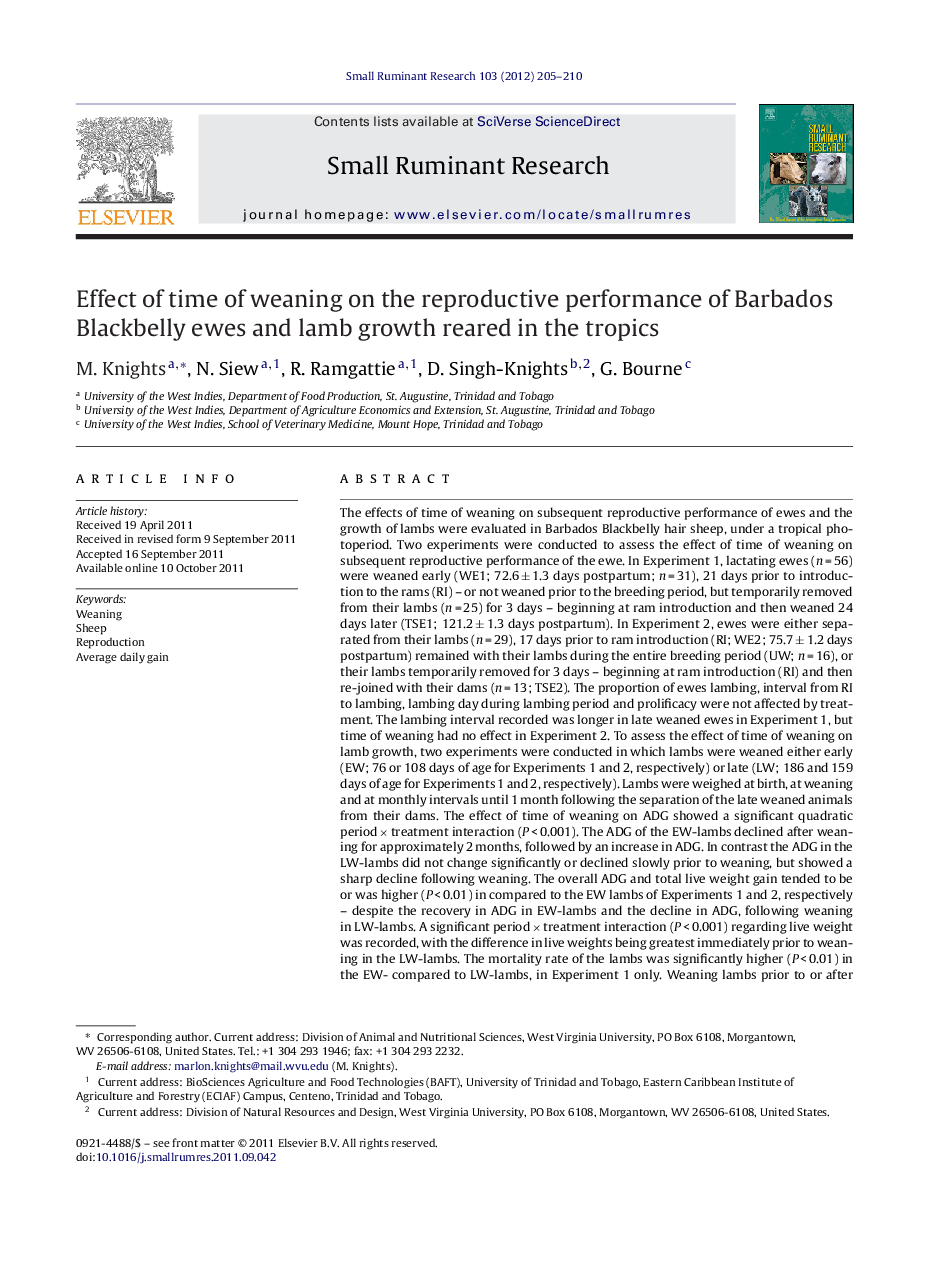| کد مقاله | کد نشریه | سال انتشار | مقاله انگلیسی | نسخه تمام متن |
|---|---|---|---|---|
| 2457277 | 1554389 | 2012 | 6 صفحه PDF | دانلود رایگان |

The effects of time of weaning on subsequent reproductive performance of ewes and the growth of lambs were evaluated in Barbados Blackbelly hair sheep, under a tropical photoperiod. Two experiments were conducted to assess the effect of time of weaning on subsequent reproductive performance of the ewe. In Experiment 1, lactating ewes (n = 56) were weaned early (WE1; 72.6 ± 1.3 days postpartum; n = 31), 21 days prior to introduction to the rams (RI) – or not weaned prior to the breeding period, but temporarily removed from their lambs (n = 25) for 3 days – beginning at ram introduction and then weaned 24 days later (TSE1; 121.2 ± 1.3 days postpartum). In Experiment 2, ewes were either separated from their lambs (n = 29), 17 days prior to ram introduction (RI; WE2; 75.7 ± 1.2 days postpartum) remained with their lambs during the entire breeding period (UW; n = 16), or their lambs temporarily removed for 3 days – beginning at ram introduction (RI) and then re-joined with their dams (n = 13; TSE2). The proportion of ewes lambing, interval from RI to lambing, lambing day during lambing period and prolificacy were not affected by treatment. The lambing interval recorded was longer in late weaned ewes in Experiment 1, but time of weaning had no effect in Experiment 2. To assess the effect of time of weaning on lamb growth, two experiments were conducted in which lambs were weaned either early (EW; 76 or 108 days of age for Experiments 1 and 2, respectively) or late (LW; 186 and 159 days of age for Experiments 1 and 2, respectively). Lambs were weighed at birth, at weaning and at monthly intervals until 1 month following the separation of the late weaned animals from their dams. The effect of time of weaning on ADG showed a significant quadratic period × treatment interaction (P < 0.001). The ADG of the EW-lambs declined after weaning for approximately 2 months, followed by an increase in ADG. In contrast the ADG in the LW-lambs did not change significantly or declined slowly prior to weaning, but showed a sharp decline following weaning. The overall ADG and total live weight gain tended to be or was higher (P < 0.01) in compared to the EW lambs of Experiments 1 and 2, respectively – despite the recovery in ADG in EW-lambs and the decline in ADG, following weaning in LW-lambs. A significant period × treatment interaction (P < 0.001) regarding live weight was recorded, with the difference in live weights being greatest immediately prior to weaning in the LW-lambs. The mortality rate of the lambs was significantly higher (P < 0.01) in the EW- compared to LW-lambs, in Experiment 1 only. Weaning lambs prior to or after the breeding period did not improve the subsequent reproductive performance of dams, but increased the mortality rate of lambs in some cases, and resulted in an accelerated decline in growth rates, regardless of the age of weaning in hair sheep reared under a tropical photoperiod. Management systems in which the ewes are re-bred 2.5–3.5 months after lambing, and lambs are reared with the ewes until market at 6.5–7.5 months of age provide an opportunity to maximize productivity of ewes, in relation to kg lamb marketed annually.
Journal: Small Ruminant Research - Volume 103, Issues 2–3, April 2012, Pages 205–210